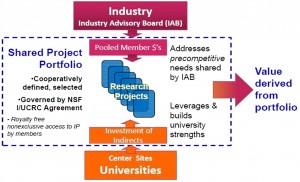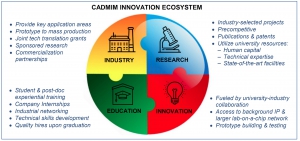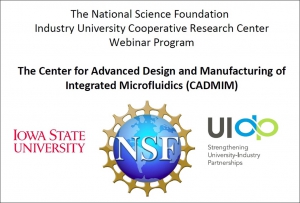Our Mission
As a National Science Foundation (NSF) Industry/University Cooperative Research Center (I/UCRC), the Center for Advanced Design and Manufacturing of Integrated Microfluidics (CADMIM) will develop microscale tools and technologies aimed at simpler, faster, and cheaper analytical solutions addressing human health, agriculture, and the environment.
Analytical solutions are needed everywhere – the environment, agriculture, food and water supplies, and ultimately for human health and safety. These solutions are not currently feasible, however, due to inefficient, cumbersome, and/or expensive existing methods. Yet rising healthcare costs and at-risk populations create a need for cheaper, more convenient solutions. The development of new medicines requires millions of compounds to be screened efficiently. To feed a growing global population, faster breeding and testing of new crop varieties is required. Results of livestock screens for disease are not available for hours or days. Ocean and urban runoff assays rely on culture-based laboratory results that take days to acquire – too late to prevent beach closures. In each of these application areas, fluidic samples must be analyzed quickly, accurately, and with the lowest cost/test possible. Bioanalytics have potential roles along entire chains of interconnected factors – environmental conditions influence agricultural practices and yields, which influence the availability and quality of food, which affect health, prices, and the nation’s economic status.
(Click to enlarge)
Through the CADMIM Innovation Ecosystem, the center will advance interdisciplinary research and education in the science, engineering, and applications of labs-on-a-chip, with emphasis on design and scalable production. Our approach focuses on the development of highly functional platforms equipped with microfluidic components, chip‐sized devices with high sensitivities (nM ‐ pM) and short reaction times (< 1min), capable of biochemical analyses in miniaturized volumes (μl ‐ pl). The technology developed through CADMIM will revolutionize the way we assess the environment, agriculture, forensics, and human health.
CADMIM benefits include access to world class facilities and ample opportunities to capture follow-on funds through strategic industry-academic teaming. CADMIM research includes organ-on-a-chip platforms, self-driven microfluidic systems, sweat sensing, compound screening, multiplexed cellular assays, droplet-based microfluidics, electrochemical sensing, and single cell and molecular analysis.
The expected outcomes of this center include:
- Effective, long‐term industry/university partnerships addressing industry’s most pressing challenges.
- Multidisciplinary technical and commercial training of the next generation workforce in design and process methodologies geared towards cost-effective, high volume production of biochips.
- Disseminating our acquired knowledge through publications and patents.
- Bringing efficient, convenient, low-cost analytical solutions to fruition for broad societal benefit.
How CADMIM Works:
CADMIM is currently composed of 2 sites: University of California, Irvine and the University of Illinois at Chicago. The center is co-funded by NSF and the industrial members.
![]()
![]()

CADMIM is based on a shared portfolio of research projects that address the needs of the industry members. The center’s industry members comprise the Industrial Advisory Board (IAB), which works with the universities to define relevant fundamental research projects. The center thus addresses pre-competitive needs shared by the industrial members and allows these companies to access the expertise and talents of the center faculty and the world class facilities at center sites. In turn, the faculty and students involved in center projects gain the knowledge and experience necessary to facilitate the transition from academia to industry – both from a technical and business standpoint.

Diagram showing how the various stakeholders of CADMIM work together to derive shared value. Click to enlarge.
IAB members also serve as project mentors and monitor progress via monthly team web conferences. Additional monthly center web conferences for IAB members and faculty facilitate regular discussion of center developments and issues. The entire center gathers twice a year for project selection and project updates.
A CADMIM overview webinar was recorded in 2018 and is available on the UIDP website here: https://www.uidp.org/webinar/cadmim-webinar/
CADMIM History:
In September 2012 UC Irvine and U. Cincinnati submitted a planning grant proposal to NSF for CADMIM. This proposal was selected for funding and we held a planning meeting at UC Irvine May 7 – 8, 2013. We submitted the full proposal for CADMIM in September 2013. We’ve been an official NSF I/UCRC since March 2014. In August 2016, Dr. Ian Papautsky (Center Co-Director) moved from U. Cincinnati to U. Illinois at Chicago, and our second site transitioned with him. U. Cincinnati remains involved as an affiliated site of the center. For more information about the NSF I/UCRC program and a list of the other I/UCRCs in the US, see here: http://www.nsf.gov/eng/iip/iucrc/


